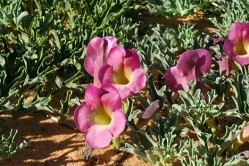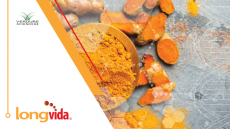Review of devil’s claw data reveals history of use, multiple benefits for under appreciated botanical

The weighty new review comes from medicinal plant expert Thomas Brendler, founder and CEO of the consulting firm Plantaphile. The review was published this week in the journal Pharmaceuticals.
“It has been on my radar for a long time and I always wanted to do this bibliography. Every stone you turn over in this story, you find something else. It just never got much of a foothold in the US market, but in Europe it has been around and very prominently so since the 1950s,” Brendler told NutraIngredients-USA.
Brendler has complied a 56-page bibliographical review of the botanical's history and clinical evidence backing its effects. The common names devil’s claw, grapple plant and others refer actually to two very closely related species, Harpagophytum procumbens and Harpagophytum zeyheri. The rather unattractive common names allude to the painfully tenacious spiked and barbed seeds of the plants.
Native to Namibia
The botanical is native to a large portion of the desert and arid savanna ecosystems in Southern Africa. The vast majority of the modern trade in the plant comes out of the country of Namibia, whose eastern half is covered by the Kalahari Desert.
It was in Namibia that the botanical first came to the attention of western herbalists. From 1884 to 1914 present day Namibia was a German colony, then known as German Southwest Africa (Deutsche Südwest Afrika). Germans were international leaders in botanical discovery as well as other expeditionary fields (such as archaeology) before more or less vanishing from the world stage in the aftermath of World War I.
The German connection
But a few Germans were (and still are) active in the country’s former colonies. A couple of ethnic Germans, a local farmer and a visiting scientist, compared notes about the traditional uses of the plant while in an internment camp in Namibia during World War II.
Brendler said as a result of that connection, powdered forms and extracts of the plant first came to prominence as dietary supplement ingredients in the German market. Use of the botanical then spread to France and the UK. The main indications for the plant have been to alleviate pain and discomfort among arthritis sufferers and for use in cases of lower back pain.
The low-growing desert plant forms tubers along lateral roots emanating out from a central root ball. It is these tubers that are harvested, dried and ground that form the basis of the medicinal use of the plant.
The Schneiderman affair
Prior to the publication of Brendler’s review, devil’s claw most recently came to widespread attention in the US in 2015 as a sort of second front opened by then New York Attorney General Eric Schneiderman in his offensive against the dietary supplement industry. Schneiderman, who has since resigned and has had his law license suspended over allegations he choked and slapped female colleagues, contended that DNA tests showed that many devil’s claw supplements contained H. zeyheri but not H. procumbens. As the former is less expensive than the latter, the allegation was that manufacturers were improperly using a cheap substitute for the ‘real’ stuff.
The trouble with that allegation, Brendler said, is that from the beginning the two species have been used interchangeably. It’s another example of a set of closely related species (another example is willow bark) that express similar active constituents and so can fall under one common name as far as their use as dietary ingredients are concerned. As far as can be determined, he said, the research on the botanical has been done with one sort of mixture or another.
Complex chemistry of botanical
That points to the fact brought out in Brendler’s review that while the botanical’s biological effects and mechanisms of action are pretty well understood, the precise constituents of the plant responsible for these effects are not. For example, one of the plant’s constituents, called harpagoside, a cinnamoylated iridoid glycoside, can be used a marker for testing the identity a given lot of product. But that doesn’t mean that this is the only—or even the most important—active constituent.
“However, whether harpagoside is more than a just marker, but also the (only) active compound, remains to be demonstrated. Consequently, superiority of H. procumbens over H. zeyheri cannot be derived merely from harpagoside content. Lower levels of harpagoside do not necessarily translate to lower levels of total iridoids, and phytochemically distinct extracts from H. procumbens and H. zeyheri have shown similar in vivo analgesic and anti-inflammatory properties,” Brendler wrote in his review.
Brendler said a wealth of research has been done on the plant, much of which has flown under the radar on this side of the pond as a consequence of the small sales of the supplement. He included mention of 694 studies done on the plant, of which 50 were clinical studies done on humans. Research interest peaked in the early 2000s, with more than 40 studies published annually.
Relationship of species still needs to be teased apart
Brendler said more work needs to be done determine whether H. procumbens is in fact superior to H. zeyheri and why. And more work needs to be done to characterize the plants in the field to determine how and where populations overlap, how they are interrelated on a genetic level, etc. The fact that mixtures of varying composition are still in the market will continue to be a confounding factor for the wider adoption of the botanical.
“In view of the interchangeable use of both Harpagophytum species and mixtures thereof in clinical practice, further comparative examination of the composition of both species is needed. Verbascoside as an anti-inflammatory compound present in Harpagophytum could be an interesting target of future research,” Brendler wrote.
“Despite some inconsistent outcomes and contradictory results, pharmacological evidence appears to be overall sufficient to support clinical use. Sufficient pharmacological differentiation between Harpagophytum species, however, is lacking,” his conclusion added.
“While there may be strong clinical evidence that devil’s claw preparations are effective in the treatment of degenerative joint diseases and musculoskeletal disorders in principle, this conclusion cannot be extended to specific preparations, because of the varying pharmaceutical quality of individual preparations,” he added.
Source: Pharmaceuticals
2021,14,726. https://doi.org/ 10.3390/ph14080726
From Bush Medicine to Modern Phytopharmaceutical: A Bibliographic Review of Devil’s Claw (Harpagophytum spp.)
Author: T. Brendler















